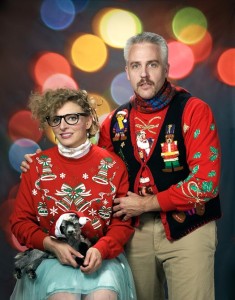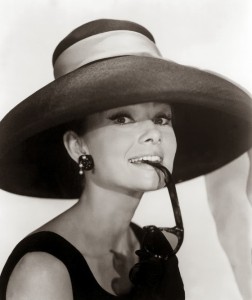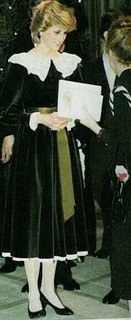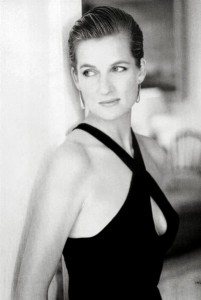So there I was, standing in the corner at the Christmas party Friday, nursing my apple-tini and watching the crowd, when my friend Trent sidled up.
Trent’s dream job is to be Clinton Kelly on “What Not to Wear” so at the party he was mentally undressing the women and then re-dressing them. He is also a disciple of the Alice Roosevelt Longworth axiom “If you can’t say anything nice about somebody, come sit by me.” (Teddy’s daughter once described Calvin Coolidge as “looking like he was weaned on a pickle.”) And this being a Christmas party, you can imagine that Trent had a lot of material.
He says that there’s something about dressing up that just confounds some women down here in South Florida, particularly during the holidays. I have to agree with him. Women start out okay with maybe a little black dress. But then too many pile on every button and bow, every piece of bling they own. Trent calls it “the Full Boca.”
Okay, I’m picking on the women here, but men have it easy when it comes to formal wear; you have to try really hard to mess up a tux. But women? Some of them just don’t know when to leave well enough alone.
And standing there at the party with Trent, I realized a lot of writers have this same problem. Me, included. So let’s talk about description and how to keep your book from turning into an ugly Christmas sweater.
Description is maybe the most potent tool in our narrative toolbox. It sets a mood, signposts a sense of place, and renders characters into flesh and blood. Description has the crucial function of letting the reader
sense — see, hear, smell, feel and taste — what it going on in your story. If your description is truly compelling, it can make a reader believe in things that are otherwise incredible. Think of what Stephen King does with “Salem’s Lot.” By making his mythical Maine town come alive through description, we are willing to suspend disbelief when the vampires start showing up.
Speaking of King, here’s what he says in his book “On Writing”:
“Description begins with visualization of what it is you want the reader to experience. It ends with your translating what you see in your mind into words on the page. It is far from easy. We’ve all heard someone say, ‘Man, it was so great (or horrible/ strange /funny)…I just can’t describe it!’ If you want to be a successful writer, you must be able to describe it, and in a way that will cause your reader to prickle with recognition. If you can do this well, you will be paid for your labors. If you can’t, you’re going to collect a lot of rejection slips.”
“Prickle with recognition.” Isn’t that a great way to put it?
Why do so many of us struggle with description? I think it’s because many writers don’t know how much description to use. Some don’t use enough. But usually, they have way too much. Description is narrative and narrative disrupts action. So a little goes a long way.
Which brings us back to the little black dress. When description is working well, it is concise and evocative. It also concentrates on a few well-chosen specific details that imply a host of other unspecific details. When Holly Golightly got dressed to go visit Uncle Sally in prison, she didn’t junk up her Givenchy. Just sunglasses and that great hat.
So how do you find your happy medium? How do you know when you’ve gone too far or haven’t gone far enough? How do you resist gilding the lily? There are no easy answers but here are a few things to think about:
Don’t generalize: Try to avoid abstractions. Be concrete in your descriptions. Instead of saying someone played a board game, say it’s Monopoly. Instead of a “bad smell” use the specific “like sour milk.” But again, don’t reach too hard or you look silly.
Don’t forget to compare and contrast. The secret to originality is the ability to see relationships. If you’re describing something green, it’s your job to come up with something fresher than “grass.” Here’s one of my faves from Steinbeck: “The customers were folded over their coffee cups like ferns.” And come to think of it, Alice’s description of Calvin Coolidge as “looking like he was weaned on a pickle” is pretty good. But again, don’t strain for originality or you just sound pretentious.
Don’t lean on adjectives: Just lining up a string of modifiers is lazy writing. (ie tall, dark and handsome). Try to find one vibrant adjective rather than several weak ones. But again, don’t strain or reach for the Thesaurus. Sometimes a lawn is just a lawn…not a “verdant sward.”
Don’t use cliches: It’s easy to slip into tired, flabby words. If you want to say something is white, you can’t use “white as snow.” It’s not yours! Neither is “thin as a rail, sick at heart, hard as a rock” or even “overcome with grief.” Time has eroded all those. It’s your job to find new ways of making your reader experience your fictional world.
Yeah, it’s tough to dress your writing for success. But don’t despair. Description is one of the things that you can get better at. Believe me, I know. I used to lard my paragraphs with lovingly crafted images that dammit, were going to stay in there because I worked so hard on them. But then my sister told me one day that I was — ahem — dressing to impress. I made every writer’s biggest mistake: I fell in love with the sound of my own voice and was trying to be “writerly.”
Finding your style — be it writing or fashion — is a lifelong process. When I went to my prom, I looked like a cross between Scarlett O’Hara and a Kabuki dancer. Through practice, I look a little better these days. Likewise, in my writing, I have learned what to leave off, what to cut out. In fact, I have gone too far with my WIP so my critique group friends tell me I am now underwriting and they are advising me to add more description.
Here is Stephen King again:
“Description is a learned skill, one of the reasons why you cannot succeed unless you read a lot and write a lot. It is not a question of how-to, you see; it is also a question of how much to. Reading will help you answer how much, and only reams of writing will help you with the how. You can only learn by doing. “
I’ll leave you with one final fashion icon as metaphor. If you try hard, you can get better at this. If she could go from this:
To this:
So can you.





I’ve been all over the place as far as how-much description to add/keep goes. I started with too much, but when I started cutting back, I cut back until it sounded bland. Now I’m not so sure where I stand, but I’m still looking for my style; whether I’m commercial fiction or literary fiction, and I guess that’s a big factor in the how-much decision. Thanks for sharing, PJ 🙂
Bonee, I sympathize. It is a career-long process, I think, finding your style. I wouldn’t sweat the distinction between literary and commercial. It’s a construct of editors and the folks who shelve the books. “Commercial” should mean that a book finds its audience and, well, sells. Nothing shameful about that.
“Learn what to leave off.” Spot on advice, Kris.
The purpose of description is to spur the reader’s imagination to fill in the blanks. I try to make them as brief as possible, but, to use King in ON WRITING again, to provide the telling detail I want the reader ot use and remember. The reader can provide the rest, as suits his or her imagination.
“Fill in the blanks.” Gonna quote you on that one, Dana. And thank God for that lovely blank spot in the reader’s imagination.
Great post. As a reader I like few details. And I like them all up front. Once I’ve painted a mental picture, I hate it when the author adds a detail that’s different than what I was imagining. I become less involved in the story.
Great personal detail about Trent. A guy who mentally undresses women and then RE-DRESSES them? Not your typical guy!
Excellent post, Kris! Clear, concrete, spot-on advice for writers — in an entertaining read! I’ll be promoting this post on social media and sending my clients here to read it. 🙂
P.S. Love that photo of the holiday sweaters! 🙂
It was the highlight of my day…trolling for the ugliest picture I could find.
Description is not to help the reader see the scene, but to feel it. Leave out any descriptive prose that doesn’t feed that effect.
Right on!
JSB–that is the wisest, most succinct thing I’ve ever read regarding description. If description doesn’t work to establish a certain emotive state of mind in the reader–or inform the reader about the state of mind of the POV character–something is wrong. Thank you.
Love this post, Kris. My peeps are retweeting it. Happy holidays!
Back at you, Jordan. Merry Christmas to all the ZK folks out there.
Description in viewpoint is also an excellent way to reveal character. An artist will see the sky as cerulean blue while the decorator may see it as Delft blue.
The mechanic will think of a specific name for a car part while someone who knows nothing about them will describe its shape, color, or resemblance to something they understand from their knowledge.
There’s also a question of genre. Romance is sensual with sight, aroma, taste, and touch while other genres are not.
Good points all, Marilynn. I am of the mind that crime writers could take some cues from romance writers in that crime writers tend to focus too much only on sight…leaving the other senses, which are more evocative, to wither.
P.J.–
More valuable, actionable advice from TKZ–thank you. Description has been made more difficult for me by the nagging, inescapable presence of video. Not only has the blizzard of images made readers more quick to be impatient, it has also shortened the collective attention span. As a consequence, I now try to think of developing my stories–and descriptions–in short bursts, to be consumed on the run, etc. It’s no easy trick. Imagine readers of old actually looking forward to nice, leisurely descriptions. Sigh.
Interesting obversation about video, Barry. This morning, the photo editor for Life mag was talking about the pictures of the year and someone commented that a photograph, unlike video, forces the viewer to STOP and think about what he is looking at. Maybe this is why so many writers use actual location photos to flex their descriptive muscles.
P.J– I forgot to thank you for drawing attention to that blot on the social landscape, the Christmas Sweater. Nothing argues more strongly for bringing back corporal punishment
I used to have a hideous Christmas sweater. Like I said, style comes late in life to most of us. Thank God.
This comment has been removed by the author.
Excellent advice PJ. Experiencing it through the characters senses makes things come alive, especially when describing something to someone who has never experienced a particular reality.
Like trying to describe to a Floridian -25F temps with the noon sun sitting just above the horizon. Do it wrong and they have no clue what you’re talking about. Do it right and and the pull a blanket up to their chin even though they’re sitting in the 80s.
Too true, Basil, your point about knowing how to convey geographical details. We get so wrapped in our heads and stories we sometimes forget our readers are everywhere. I have an imaginary reader whom I call Edith in Des Moines who has never left her home town. I try to remember to describe things for her.
Stephen King: “Final Draft = First Draft – 10%”
Coco Chanel: ” “Before you leave the house, look in the mirror and remove one accessory.”
Both the soundest bits of editing advice ever.
Fun post! Terri
One of my favorite quotes Terri.
Hello from Rome. Wonderful, entertaining piece!
Vanity writing I call it, and yes, we all have a tendency to fall in love with our own voices. When I am suspicious I could be plunging too deep in superfluous description, I read the prose out loud. Then almost every verdant sward is exposed for the Christmas sweater that it is, and every bad smell curdles into sour milk.
Detailed descriptions of places are hardly ever necessary, The real show is in the mind of the protagonist. I’d rather read about her thoughts and internalization and very rarely in thrillers are characters admiring the decor. Unless it’s part of the underlying mystery.
Thanks for an early morning chuckle!
Thanks AM! How nice to know I am read in Rome. (Haven’t had a book published in Italy yet!) This makes up for it.
I read over a synopsis I wrote a few months ago – the ride went good. They had fun. Ugh. I circled all the areas where I could have been a little more specific. Needed this post today.
I dread writing description, probably because I so often skim passages of description when I read. I figure if an author takes the time to describe someone’s attire in great detail, it had better show up as a significant plot point later on. When I write, I tend to start sparse, then embellish, then realize I’ve gone too far and cut back. I think the best descriptions stay in the character’s POV and show his/her emotions as well as the simple “It looked like…” One of my crit partners is a computer programmer, and we’re always reminding him that we don’t need a blow-by-blow description, down to dimensions and compass directions, of every scene or object in the manuscript.
This is very timely for me as I’ve been wondering a lot about description lately. I am a big believer in less is more, but I am thinking maybe my stories could use a little more dressing up. ~ R.L. Black
I’m late to the party, here. Super post. Description, that can become a mouth full. I still can’t get past “weaned on a pickle.”
Good blog, Kris. I’m struggling with the description of a major character in a new book. This was a good refresher course .
Good advice. Coming up with original metaphors and similes from the character’s viewpoint is always difficult but necessary to avoid cliches.
So let’s talk about description and how to keep your book from turning into an ugly Christmas sweater. Description is maybe the most potent tool … uuglysweater.blogspot.com
So let’s talk about description and how to keep your book from turning into an ugly Christmas sweater. Description is maybe the most potent tool … ctackysweaters.blogspot.com